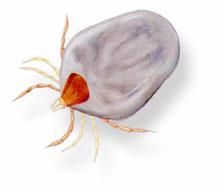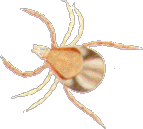ADULT FEMALE paralysis ticks
fully engorged
half engorged
non engorged
relative sizes
For a detailed description see Ixodes holocyclus
This is a half-engorged, adult, female
paralysis tick:
 It is readily
distinguished as female because the dorsal shield (the "scutum"
or "face") covers only part of dorsal surface of the
body [in the male it covers the whole body, hence the male is
colloquially called a "shell back"]. Note that the
mouthparts protrude well forward and would be readily seen
without magnification by most people. The body is pear-shaped to
oval. As the female engorges the colour changes from yellowish to
light slate grey and with a brown line circling the body when
viewed from above (see fully engorged female).
Note also that the first and last pairs of legs are brown with
the 2 middle pairs of legs being a lighter colour- this feature
distingishes the adult male and female paralysis ticks from the
other common tick species of Australia. It is when the tick is
found at this stage of engorgement (ie this size and shape) that signs of paralysis are
usually evident unless the host has pre-existing immunity. Both nymph and adult stages have eight legs. See Ixodes holocyclus Neumann for detailed taxonomic features of this tick.
It is readily
distinguished as female because the dorsal shield (the "scutum"
or "face") covers only part of dorsal surface of the
body [in the male it covers the whole body, hence the male is
colloquially called a "shell back"]. Note that the
mouthparts protrude well forward and would be readily seen
without magnification by most people. The body is pear-shaped to
oval. As the female engorges the colour changes from yellowish to
light slate grey and with a brown line circling the body when
viewed from above (see fully engorged female).
Note also that the first and last pairs of legs are brown with
the 2 middle pairs of legs being a lighter colour- this feature
distingishes the adult male and female paralysis ticks from the
other common tick species of Australia. It is when the tick is
found at this stage of engorgement (ie this size and shape) that signs of paralysis are
usually evident unless the host has pre-existing immunity. Both nymph and adult stages have eight legs. See Ixodes holocyclus Neumann for detailed taxonomic features of this tick.
This is a non-engorged female adult paralysis tick:

The relative sizes of Ixodes holocyclus tick stages (above)
can be gauged by the following ruler:
|_______________1 cm________________|
Note that larval (6-legged) stages are
extremely small, with body lengths varying with stage of
engorgement from 0.5 to 1.5 mm.
The Paralysis Tick of Australia - Home
E-mail Us to report a broken link!